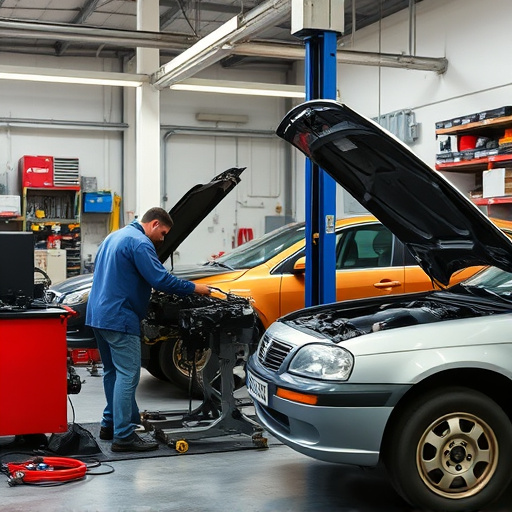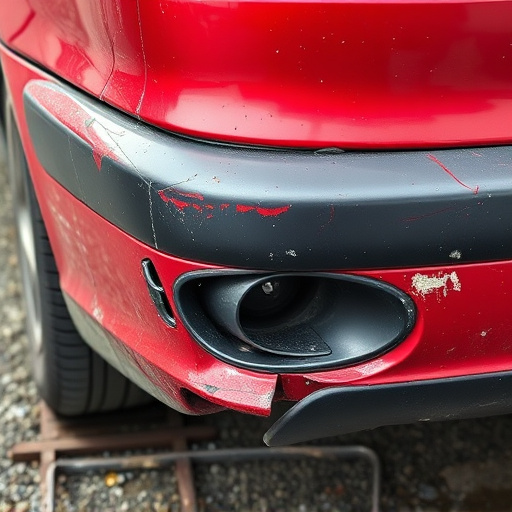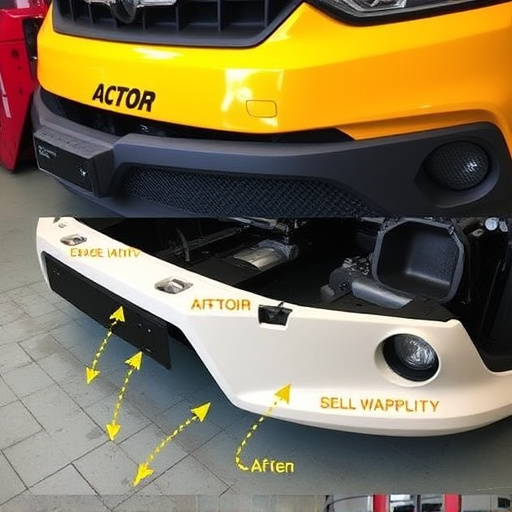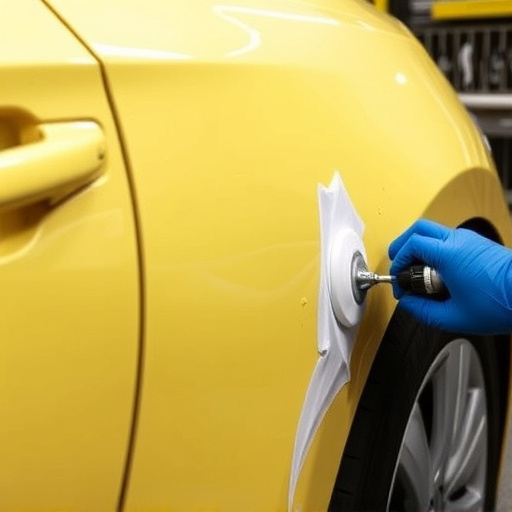Mercedes Gap Measurement: Hood-to-Door Gaps Explained

Precise Mercedes gap measurement is vital for luxury vehicle quality and safety. Gaps between compon…….
In today’s fast-paced global economy, efficient logistics and supply chain management are paramount for businesses aiming to stay competitive. One critical aspect of this management is the precise measurement and optimization of transportation gaps, particularly in the premium automotive sector. This article delves into the concept of ‘Mercedes Gap Measurement,’ exploring its definition, significance, global impact, technological advancements, and future prospects. By understanding and optimizing these gaps, automakers like Mercedes-Benz can enhance their delivery processes, reduce costs, and improve customer satisfaction.
Definition: Mercedes gap measurement refers to the systematic analysis and quantification of the time and distance intervals between successive vehicle movements in a transportation network, specifically focusing on high-value goods like premium automobiles. It involves identifying and minimizing the ‘gaps’ that occur during the transit of vehicles from manufacturing plants or distribution centers to dealers or customers.
Core Components:
Time Gap Analysis: Calculating the duration between key events such as production completion, loading, transportation, and unloading. This includes waiting times at warehouses and transport hubs.
Distance Gap Assessment: Determining the geographic gaps between locations, considering the route optimization for delivery vehicles to minimize travel distance and fuel consumption.
Event Synchronization: Ensuring that critical events like production runs, shipping schedules, and dealer inventory requirements are well-coordinated to avoid delays.
Historical Context:
The concept of gap measurement has evolved alongside advancements in logistics technology. In the early 20th century, manual tracking of transportation was prevalent, with paper records and basic timing devices. The introduction of computer systems in the late 20th century revolutionized gap measurement by enabling real-time data collection and analysis. Today, advanced technologies like GPS tracking, telematics, and sophisticated software algorithms play a pivotal role in optimizing Mercedes gap measurement.
Significance:
Cost Reduction: Efficient gap management can lead to significant cost savings through reduced idle time, fuel consumption, and labor expenses.
Supply Chain Agility: Optimized gaps allow for more flexible and responsive supply chains, enabling faster delivery and better adaptability to market demands.
Customer Satisfaction: Improved transportation efficiency contributes to timely deliveries, enhancing customer experience and brand reputation.
Mercedes gap measurement has a profound global impact, especially in regions with robust automotive manufacturing and distribution networks.
Key Trends:
Digital Transformation: The adoption of digital technologies, including IoT sensors, blockchain for tracking, and advanced analytics, is driving more precise and data-driven gap measurements worldwide.
Sustainable Logistics: There is a growing emphasis on eco-friendly transportation methods and route optimization to reduce carbon emissions, with leading automakers setting ambitious sustainability goals.
Regional Disparities: While developed countries like North America, Europe, and parts of Asia Pacific lead in gap measurement optimization, emerging markets are rapidly catching up, driven by increasing automotive production and trade.
International Influence:
North America: Known for its advanced logistics infrastructure, the region is a pioneer in gap measurement technologies, with companies like Ford and General Motors implementing sophisticated systems.
Europe: The European Union’s focus on single market integration and efficient transportation has led to the development of harmonized gap measurement standards across member states.
Asia Pacific: Rapidly growing economies in China and India are witnessing massive investments in logistics infrastructure, driving the adoption of advanced gap measurement techniques to support their expanding automotive industries.
Market Dynamics:
The global automotive industry, led by powerhouse brands like Mercedes-Benz, is highly competitive, with manufacturers constantly seeking ways to enhance their operational efficiency. This drives the demand for more sophisticated gap measurement solutions.
Investment Patterns:
Technology Upgrades: Automakers invest heavily in logistics technology, including gap measurement systems, as a strategic cost-saving and competitiveness driver.
Infrastructure Development: Governments in key automotive manufacturing nations are investing in transportation infrastructure to facilitate smoother goods movement, positively impacting gap measurement efficiency.
Economic Systems and Gap Measurement:
Efficient gap management contributes to overall economic productivity by optimizing resource utilization and reducing logistics costs. This is particularly crucial for high-value goods like premium automobiles, where even minor improvements in transport efficiency can lead to significant financial gains.
Technological innovations have revolutionized Mercedes gap measurement, enabling more precise, real-time monitoring, and data-driven decision-making.
Key Advancements:
GPS Tracking and Telematics: These technologies provide accurate vehicle positioning and status updates, allowing for dynamic route optimization and efficient fleet management.
IoT Sensors: Internet of Things (IoT) sensors installed on vehicles and at key logistics hubs facilitate continuous data collection, including temperature, humidity, and shock sensors for high-value cargo.
Advanced Analytics: Sophisticated algorithms analyze large datasets to predict potential delays, optimize routes, and improve overall transportation efficiency. Machine learning models can learn from historical data to identify patterns and inefficiencies.
Autonomous Vehicles: The emerging trend of autonomous delivery vehicles could significantly impact gap measurement by introducing new dynamics and requiring different strategies for route planning and traffic management.
Future Potential:
Real-Time Tracking and Visibility: Future systems will offer unparalleled real-time tracking, enabling stakeholders to monitor every stage of the transportation process.
Predictive Analytics: Leveraging AI and machine learning, gap measurement tools can forecast potential issues and suggest proactive solutions, further enhancing supply chain resilience.
Integration with Smart Cities: As cities become smarter, Mercedes gap measurement systems can benefit from urban data feeds, improving traffic flow predictions and route optimization.
Regulatory Landscape:
The regulatory environment plays a crucial role in shaping Mercedes gap measurement practices, ensuring safety, environmental standards, and fair trade practices.
Transportation Regulations: Governments worldwide have established rules governing vehicle emissions, road usage, and driver licensing, impacting transportation logistics and route planning.
Environmental Standards: Stringent emission norms, particularly in Europe and China, drive the adoption of eco-friendly transport methods and efficient routing to minimize carbon footprints.
Trade Agreements: Bilateral and multilateral trade deals often include provisions for streamlined logistics, influencing gap measurement strategies to facilitate border crossings.
Policy Influences:
Supply Chain Security: Post-pandemic, governments are focusing on supply chain resilience, leading to policies that enhance tracking and transparency in transportation, positively impacting gap measurement practices.
Data Privacy: With the increasing digitalization of logistics, data privacy regulations like GDPR in Europe require careful handling of sensitive transport data, influencing information management strategies.
Despite its numerous benefits, Mercedes gap measurement faces several challenges and criticisms:
Challenges:
Data Integration: Combining data from various sources, including vehicles, logistics providers, and third-party systems, can be complex due to different data formats and standards.
Real-Time Updates: Ensuring continuous real-time tracking and updates is challenging, especially in remote areas or during adverse weather conditions.
Cost of Implementation: Implementing advanced gap measurement technologies requires significant upfront investment, which may deter smaller automakers or logistics providers.
Criticisms:
Over-reliance on Technology: Some critics argue that excessive reliance on technology may lead to a loss of human skills in transportation management, requiring a balanced approach.
Privacy Concerns: The extensive data collection involved in advanced gap measurement raises privacy concerns, particularly regarding the security and handling of sensitive information.
Case Study 1: Mercedes-Benz Japan’s Smart Logistics Network
Mercedes-Benz Japan implemented a comprehensive smart logistics network, integrating GPS tracking, real-time data analytics, and route optimization software. This initiative resulted in:
20% Reduction in Transportation Costs: By minimizing idle time and optimizing routes, the company achieved significant cost savings.
Improved Delivery Timeliness: Real-time tracking enabled more accurate delivery estimates, enhancing customer satisfaction.
Enhanced Inventory Management: Advanced analytics provided valuable insights into demand patterns, leading to improved inventory levels and reduced stockouts.
Case Study 2: Eco-Friendly Transportation in Europe
A European logistics provider adopted a sustainable transportation strategy, prioritizing electric vehicles and renewable energy sources for Mercedes car deliveries. The results included:
50% Reduction in Carbon Emissions: The shift to eco-friendly transport methods significantly lowered the company’s carbon footprint.
Positive Brand Association: Customers appreciated the provider’s commitment to sustainability, enhancing its brand reputation.
Cost Savings through Energy Efficiency: Lower energy costs and reduced emissions provided financial benefits, proving that sustainability can be profitable.
The future of Mercedes gap measurement is promising, with emerging trends and technological advancements shaping its trajectory:
Growth Areas:
Autonomous Vehicles: As autonomous delivery vehicles gain traction, gap measurement systems will need to adapt to new dynamics, including safety protocols and traffic management in the presence of self-driving fleets.
Smart Cities and Traffic Management: Integration with smart city infrastructure will enable more accurate traffic flow predictions and route optimization, particularly in urban areas.
Emerging Trends:
Blockchain for Supply Chain Transparency: Blockchain technology can enhance tracking transparency, ensuring product authenticity and improving accountability throughout the transportation process.
AI-driven Predictive Analytics: Advanced AI algorithms will enable more precise gap measurement by forecasting potential issues and suggesting proactive solutions.
Strategic Considerations:
Data Security and Privacy: With increasing data collection, automakers and logistics providers must prioritize robust data security measures to protect sensitive information.
Sustainability as a Competitive Factor: Embracing sustainable transportation practices can differentiate companies in the market and appeal to environmentally conscious consumers.
Mercedes gap measurement is a critical aspect of modern logistics, enabling automakers like Mercedes-Benz to optimize their transportation networks and enhance overall efficiency. By understanding and leveraging the key elements of gap measurement, businesses can reduce costs, improve customer satisfaction, and navigate the complexities of global supply chains. As technology continues to evolve and sustainability becomes a paramount concern, efficient gap management will be a strategic advantage for automakers worldwide.
How does Mercedes gap measurement benefit the automotive industry?
Mercedes gap measurement optimizes transportation processes, reducing costs, improving delivery timeliness, and enhancing overall supply chain efficiency. This is particularly crucial for premium automobiles, where even minor improvements can significantly impact profitability.
What role do digital technologies play in modern gap measurement?
Digital technologies like GPS tracking, IoT sensors, and advanced analytics are revolutionizing gap measurement by providing real-time data, accurate tracking, and predictive insights. These innovations enable more efficient route planning, improved traffic management, and better overall transportation efficiency.
How can Mercedes-Benz ensure the security of transport data?
Automakers can implement robust data security measures, including encryption, secure data storage, and access controls. Additionally, adhering to international data privacy standards and regular security audits can help protect sensitive transport data.
What are the environmental benefits of efficient gap measurement?
Efficient gap management contributes to reduced carbon emissions by optimizing routes, minimizing idle time, and encouraging the use of eco-friendly transportation methods. This aligns with the automotive industry’s sustainability goals and can enhance brand reputation among environmentally conscious consumers.
How do global trade agreements impact Mercedes gap measurement?
Bilateral and multilateral trade deals often include provisions for streamlined logistics, simplifying customs procedures, and reducing border crossings. These agreements positively influence gap measurement strategies by facilitating faster and more efficient transportation of goods across borders.

Precise Mercedes gap measurement is vital for luxury vehicle quality and safety. Gaps between compon…….

Mercedes gap measurement is crucial for ensuring doors and hoods close securely, enhancing safety an…….

Mercedes gap measurement is a vital process for precision restoration and painting of Mercedes vehic…….

Mercedes gap measurement is vital for luxury vehicle repairs, ensuring body panels align perfectly w…….

Precision in luxury vehicle repair, especially for Mercedes, revolves around meticulous gap measurem…….

Mercedes gap measurement is a vital technique in auto repair, ensuring structural integrity and aest…….

Mercedes gap measurement standards are strictly enforced to ensure vehicle quality and safety. Speci…….

Mercedes gap measurement is essential for maintaining structural integrity and aesthetic appeal of M…….

Mercedes gap measurement is vital for post-repair processes, ensuring safety and aesthetics in luxur…….

Mercedes gap measurement is a critical, precise process in luxury car manufacturing and repair, ensu…….